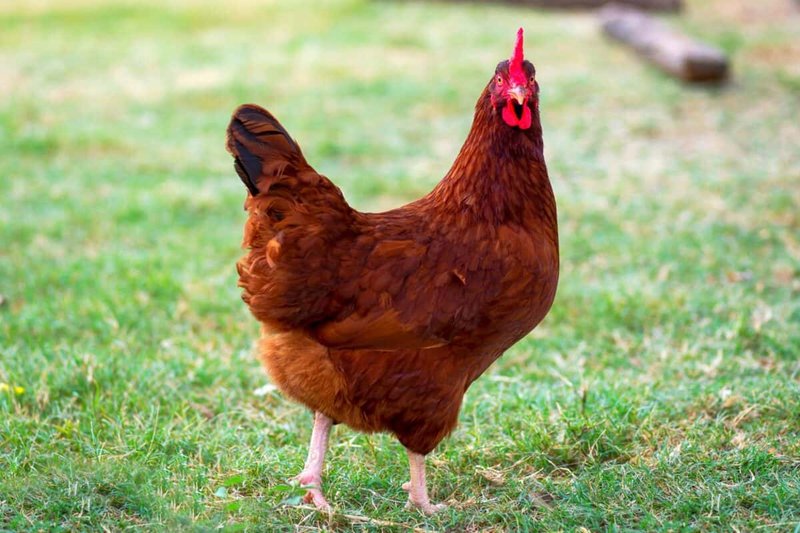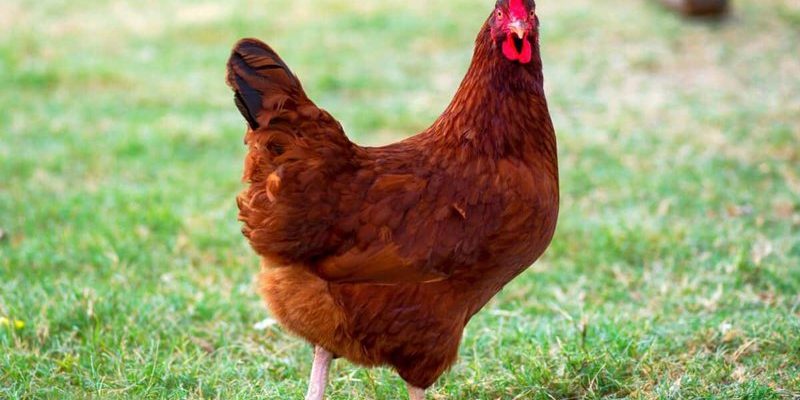
Rhode Island Reds are known for their deep red plumage and friendly demeanor, so they’re a delight to encounter. Unfortunately, they’re not native to the wild, as they’re primarily domesticated birds found on farms and in backyards. However, if you’re curious about identifying these beauties when they escape their coops or in areas where chickens roam freely, this guide will help you recognize their unique traits and behaviors. Let me show you how to spot a Rhode Island Red and appreciate this iconic breed in its natural settings.
Physical Characteristics of Rhode Island Reds
To start, it’s essential to understand what Rhode Island Reds look like. They are medium to large-sized chickens, typically weighing between 6 to 8 pounds. Their most striking feature is their rich red feathers; it’s almost as if they were painted with a warm sunset color. The feathers can range from a dark mahogany to a lighter red, but they all have that signature glow that makes them stand out.
Another distinguishing trait is their yellow legs. If you see a flock of chickens, look down! The legs of Rhode Island Reds are bright yellow, which contrasts beautifully with their feathered bodies. Additionally, their reddish-brown eyes and well-rounded shape give them a robust appearance. Chickens, like people, come in different shapes and sizes, but Rhode Island Reds have a fuller and more sturdy build.
You might also notice their combs and wattles. Rhode Island Reds usually have a single comb that stands erect on their heads. This little fleshy ridge can be a fun detail to spot if you’re observing them from a distance. Don’t forget to pay attention to their beaks—they’re short and curved, perfect for pecking at the ground for worms and seeds.
Behavioral Traits to Observe
When observing Rhode Island Reds, behavior can tell you a lot about them. These chickens are known for their friendly and calm personalities. Unlike some other breeds that might bolt at the slightest disturbance, Rhode Island Reds are generally more relaxed. If you see a group of chickens that isn’t too skittish, there’s a good chance some of them are Rhode Island Reds.
They’re also quite curious. These birds love to explore their surroundings. If you spot a chicken scratching around and investigating, it’s likely a Rhode Island Red. Their foraging behavior is characterized by scratching at the ground and pecking at anything that looks appealing—whether it’s a bug, a seed, or even a fallen leaf.
Rhode Island Reds are known for their social nature, too. They tend to stick together in small groups, often chatting with each other. If you hear clucking that sounds light and friendly, it could be a sign of Rhode Island Reds just enjoying each other’s company. Their social behaviors make them quite engaging to watch, almost like small furry friends in a hen house.
Where to Spot Rhode Island Reds
Understanding where to spot Rhode Island Reds can save you some time. These birds are primarily domestic, meaning they thrive in farm settings, backyards, and sometimes community gardens where folks keep chickens. If you’re venturing into rural areas, keep an eye out for small farms. Often, farmers choose Rhode Island Reds for their hardiness and egg-laying capabilities.
You might also find them in local parks or backyard coops if you’re in a suburban area. Chickens can sometimes wander if they get the chance, so don’t be surprised if you come across one at a nearby garden. However, spotting them in a truly “wild” setting is rare, as they generally don’t roam far from home.
If you’re on a mission to find them, ask around! Local farmers or chicken enthusiasts can lead you to the right places where Rhode Island Reds are raised. They may even share tips on their unique behaviors or quirks, which can enhance your observational experience.
Comparing Rhode Island Reds to Other Breeds
You might wonder how Rhode Island Reds compare to other chicken breeds. A common breed you might encounter is the Leghorn, which is known for its white feathers and more active, flighty nature. In contrast, Rhode Island Reds are sturdier and more laid-back.
Another breed to keep in mind is the Plymouth Rock. While Plymouth Rocks have distinct striped feathers, their friendly demeanor is similar to that of Rhode Island Reds. The primary difference is in their markings, as Plymouth Rocks are often gray with white stripes, while Rhode Island Reds are solid shades of red.
Comparing these breeds can be enjoyable and insightful. Take a moment to appreciate their differences. Whether it’s feather colors or behaviors, each breed offers something unique to observe in the wild.
Conservation and Care of Rhode Island Reds
Even if they aren’t found in the wild like some wild birds, Rhode Island Reds hold a significant place in poultry farming. They’re resilient, easy to care for, and great layers of brown eggs. If you’re considering keeping chickens, understanding their needs can be incredibly fulfilling.
Rhode Island Reds thrive in spacious environments with plenty of room to roam and forage. They also require clean water and a balanced diet to stay healthy and happy. Small farms often provide these essentials, allowing them to enjoy a good quality of life.
If you spot a Rhode Island Red at a local farm or community garden, you might get a chance to learn more about their care. Engaging with local farmers can provide insight into how these birds are kept and what it takes to maintain their health. It’s a great way to appreciate their role in agriculture and how they contribute to our food systems.
Enjoying Your Observations
As you venture out to identify Rhode Island Reds, just remember to enjoy the experience. Whether you’re in a rural area, a park, or just wandering through a neighborhood, observing these chickens can be a delightful encounter. Take a moment to slow down, watch their behaviors, and appreciate their unique characteristics.
You might find that these laid-back birds offer a sense of joy and calm as they scratch around, socialize, and bask in the sun. Rhode Island Reds, with their friendly nature and striking appearance, embody the charm of chickens. So, next time you’re out and about, keep an eye peeled for these fantastic fowls!
In conclusion, whether you’re an avid birdwatcher or just someone curious about Rhode Island Reds, observing these chickens can be a wonderful experience. You’ll not only learn to identify them but also gain a deeper appreciation for these delightful birds that thrive in our backyards and farms. Keep exploring, and who knows what other fascinating creatures you might discover on your adventures!

